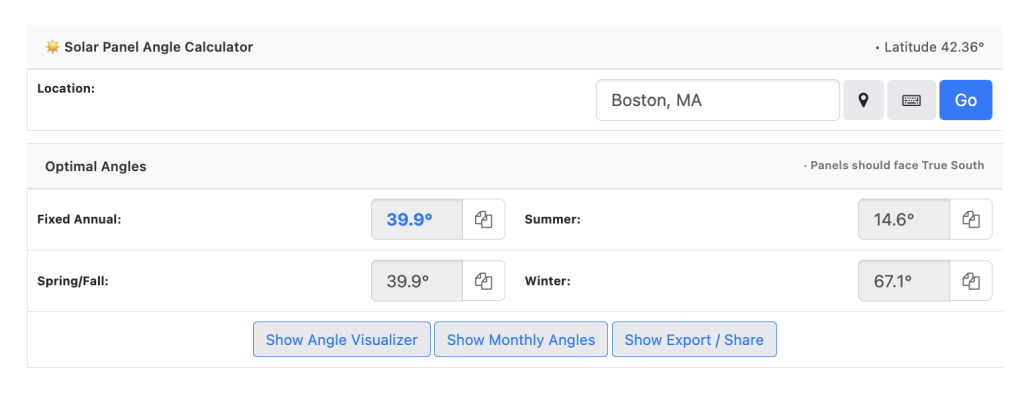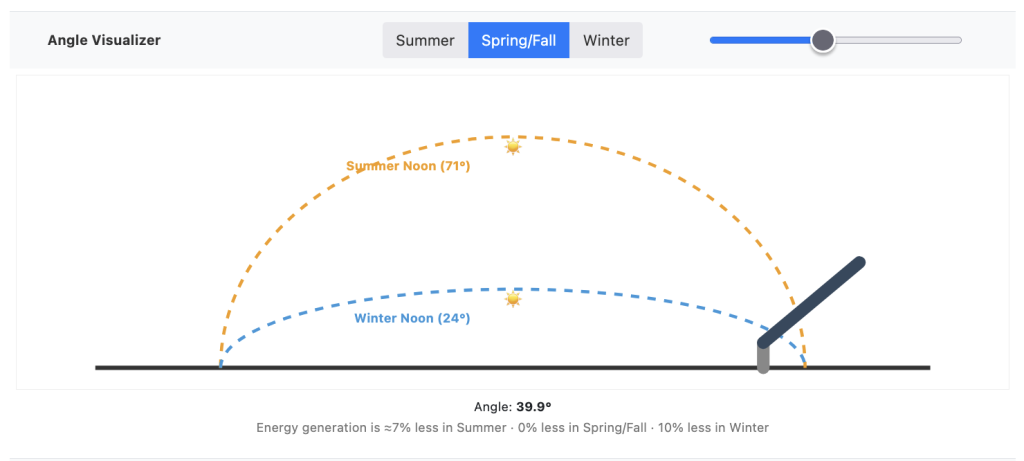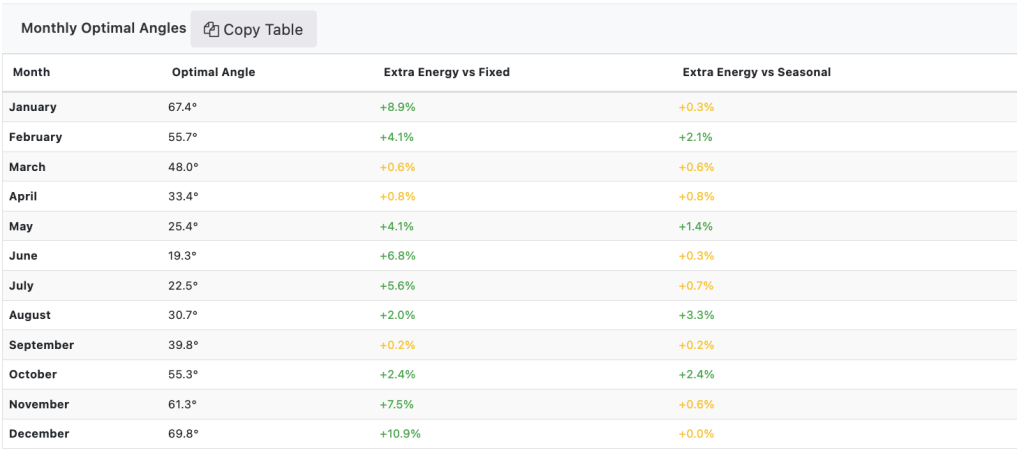Our solar panel angle calculator takes the guesswork out of panel positioning, suggesting panel tilt angles based on your location's latitude and your willingness to reposition based on the sun's seasonal dance across the sky.
Solar panel angle calculations
Start by entering your location in the search box. The calculator accepts over 150,000+ cities with auto suggestions worldwide. Alternatively, click the location button to use device location (with permission), or even manually enter your latitude if you're feeling particularly precise.
Once you hit Go, see four key angles:
- Fixed Annual - Your set-it-and-forget-it angle for year-round optimization
- Summer - Best angle for peak production months (May-Aug in the northern hemisphere and Nov-Feb in the southern hemisphere)
- Winter - Optimized for lower sun angles when you need as many photons as you can get
- Spring/Fall - The shoulder seasons that often match your annual optimum
Each angle includes a copy button so you can quickly grab the numbers for your installer or your own reference.

Interactive angle visualizer
Click Show Angle Visualizer to see your panels in action. The side-view diagram shows your panel at different tilt angles, with summer and winter sun paths arcing overhead.
Drag the slider to experiment with different angles and watch the efficiency percentages listed below the visualization change. The visualization updates in real-time, showing you an estimate of how much theoretical/potential energy you're gaining or losing compared to each season's optimum. Obviously, your panel technology and type will have an effect here, but the tool will give you a decent baseline.
The seasonal buttons (Summer, Spring/Fall, Winter) snap the visualizer to the calculated optimal angles. It's particularly eye-opening to see how dramatically the winter sun sits lower in the sky – and yes, that's why steeper angles help so much during those short winter days.

Monthly fine-tuning and efficiency gains
If you're, let's say, optimization obsessed, click Show Monthly Angles to reveal the monthly adjustment table. This is where things get interesting from a numbers perspective – I show the payoff if you're willing to adjust your panel angle 12 times a year.
The table shows three key comparisons for each month:
- Optimal Angle - The tilt for maximum solar collection
- Extra Energy vs Fixed - How much more energy you'd collect compared to leaving panels at the annual optimum (which typically works out to 5-8% more)
This percentage represents the total "lost" energy over a year if you choose the convenience of a fixed angle. For a large array, this can add up to a significant amount of power. - Extra Energy vs Seasonal - The incremental gain from going to monthly (12x) vs. seasonal (4x per year) adjustments
Monthly adjustments require tilting your panels 12 times per year. If you are installing fixed panels, you'll adjust them only a single time – when you install them.
The Copy Table button exports all monthly data as tab-separated text, perfect for dropping into a spreadsheet and taking the calculations to levels I couldn't even imagine when building the tool.

Export and documentation features
Click Show Export / Share for comprehensive export options. Choose between:
- Text Report - A human-readable text file with formulas and sources (along with your input latitude or city)
- CSV Data - Spreadsheet-friendly format with the same inputs, calculations, and methodology
How the calculations work
Seasonal approximations
Northern Hemisphere:
- Fixed/Spring/Fall:
Latitude - 2.5° - Summer:
(Latitude × 0.9) - 23.5° - Winter:
(Latitude × 0.9) + 29°
Southern Hemisphere: Same formulas with seasons reversed (because December is summer in the Southern Hemisphere).
A note about what these angles actually represent:
- The 23.5° adjustment accounts for Earth's axial tilt
- The 0.9 multiplier appears to be an empirical optimization factor accounting for atmospheric conditions and the simple fact sunlight isn't always at its peak intensity, even during summer.
- The "Fixed/Spring/Fall" angle is an annual average optimization – it's not specifically optimized for spring and fall despite the label, but represents a year-round compromise that happens to work well during the equinoxes
- This fixed angle has some built-in "slop". It's slightly shallower than latitude to bias toward better summer performance and higher year-round total power production.
Note: Another common rule of thumb is to set a fixed angle to match your latitude exactly. This does work well! However, the rule of thumb formulas build in a slight optimization that generally outperforms it over a full year.
Where the approximations come from, approximately
The seasonal angles use heuristics that are staples of the solar industry.
Based on my searching (and extensive discussions and arguments with a couple of LLMS!), these simplifications can be traced back to foundational modeling by pioneers like Hoyt C. Hottel at MIT. To make the complex physics practical, Hottel's group established the key engineering shortcut of optimizing for solar noon when the sun is at its peak.
These principles were then codified and brought to a wider audience in the definitive industry textbook, Solar Engineering of Thermal Processes by Duffie and Beckman. And now, the hand-wave: over the decades, installers and practitioners refined these principles with real-world data, leading to the rules of thumb you'll find around the web (and now here on DQYDJ!).
Monthly optimization algorithm
Unlike the seasonal rules of thumb, the monthly calculations use better math. For each month, the calculator:
- Samples multiple days throughout the month – not just the 15th, but several days to capture the sun's changing path
- Calculates solar declination using the standard equation:
23.45 × sin((360 × (284 + dayOfYear) / 365) × π/180)– This formula from the NREL Solar Position Algorithm (Reda & Andreas, 2004) calculates the sun's angle relative to Earth's equator throughout the year - Determines solar noon altitude for each sampled day:
90 - |latitude - declination| - Tests different tilt angles and calculates irradiance using the cosine law: panels collect maximum energy when perpendicular to incoming sunlight, with collection efficiency proportional to
cos(incidence angle) - Averages the results across all days to estimate the month's optimal angle
This methodology is validated by research showing monthly adjustments can increase energy collection by 7-8% compared to fixed angles.
Important disclaimers and limitations
These calculations provide estimates based on simplified formulas. Verify final designs with local installers or engineers who can incorporate local building codes, roof loading limits, shading analysis, and permitting requirements.
The calculator assumes:
- No shading from trees, buildings, multiple rows of panels, or other obstructions
- Standard atmospheric conditions
- Panels face true south (or north in southern hemisphere)
- Uniform panel mounting and electrical configuration
Real-world performance depends on countless site-specific factors. Your sunlight will vary!
Credits and technical details
The calculator leverages several key libraries and data sources:
- SunCalc.js (v1.9.0) - Powers the sun position calculations and solar path visualizations
- Cities Database: Geographic data from cities.json, sourced from GeoNames Gazetteer
Related calculators and tools
Planning a solar installation involves multiple calculations and timing considerations. Finding the next sweet post or tool takes but a single click:
- Sunrise Sunset Calculator - Determine daylight hours for your location year-round
- Golden Hour Calculator - Find optimal lighting times (handy for photographing your installation)
- Blue Hour Calculator - Calculate twilight periods for installation scheduling
- Time Zone Conversion Calculator - Coordinate with installers across time zones
- Hours Between Calculator - Calculate installation time windows
- Days Between Two Dates - Project installation timelines
- Home Affordability Calculator - Factor solar costs into housing decisions
- Cap Rate Calculator - Analyze solar investment returns for rental properties
- Sun Path Generator - See sun path for your location
- Shadow Calculator - See shadow length and angle per location
- Solar Irradiance Calculator - Calculate actual solar energy potential at your optimized angles
So there you have it – solar tilt math using everything from industry-standard rules of thumb with origin lost to the mists of time to rigorous monthly calculations. Whether you're going to set-it-and-forget it with your panels, or climb up there with a protractor twelve times a year... now you know exactly what angle to target.
